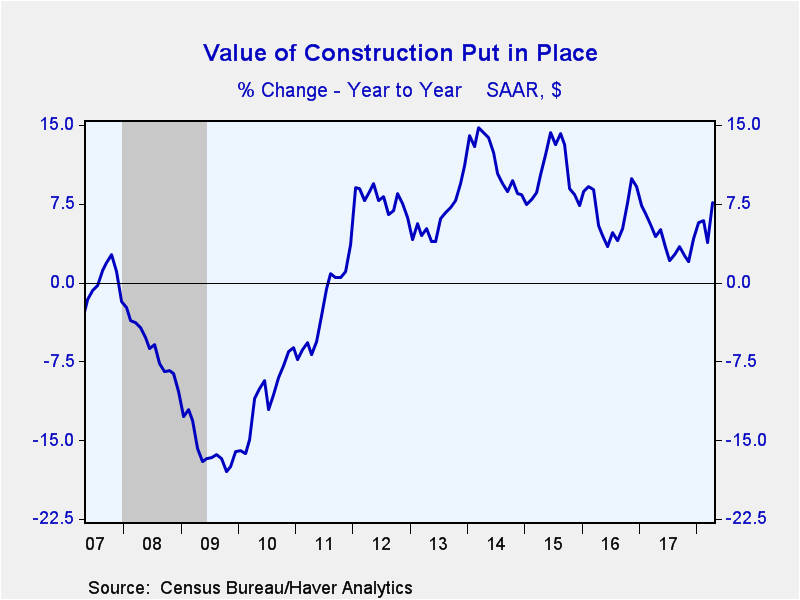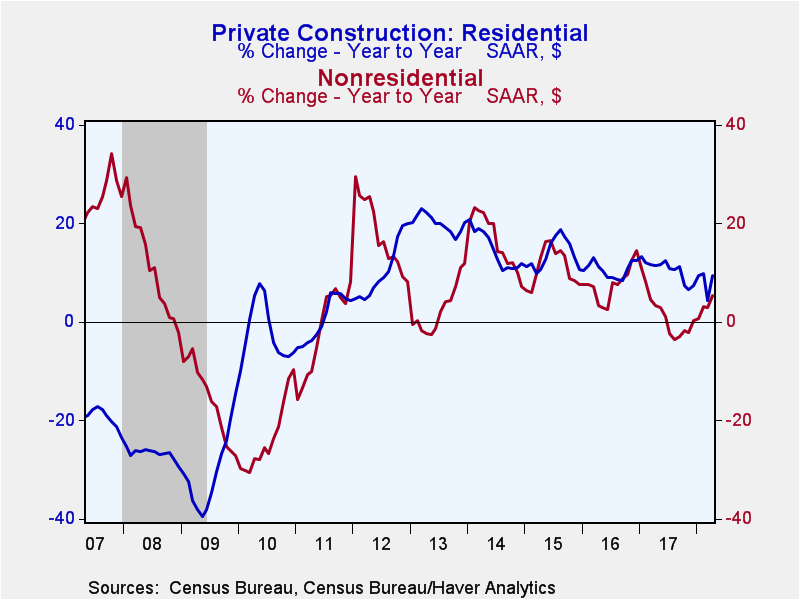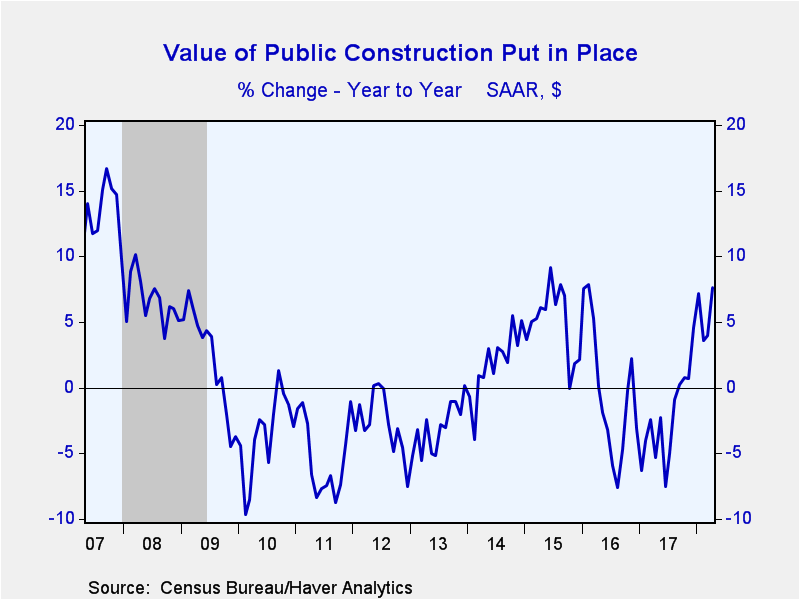 Global| Jun 01 2018
Global| Jun 01 2018U.S. Construction Spending Stronger than Expected in April
by:Sandy Batten
|in:Economy in Brief
Summary
The value of construction put-in-place recovered in April, rising a larger-than-expected 1.8% m/m (8.3% y/y) after having fallen 1.7% m/m in March (unrevised). The 1.0% m/m increase initially reported for February was revised up to a [...]
The value of construction put-in-place recovered in April, rising a larger-than-expected 1.8% m/m (8.3% y/y) after having fallen 1.7% m/m in March (unrevised). The 1.0% m/m increase initially reported for February was revised up to a 1.2% m/m gain. The Action Economics Forecast Survey had looked for a 0.8% m/m rise in building activity in April. Weather in March was unseasonal and thereby restrained construction activity. So, some of the April increase reflected a payback from the return to more normal weather. The strong April report gets the second quarter off to a very good start with construction spending already 1.1% (not annualized) above the first quarter average.
The private sector, particularly residential construction, led the April rebound. Private sector building activity jumped 2.8% m/m (8.4% y/y). The March figure was downwardly revised, but this was almost completely offset by an upward revision to February. Construction spending in March is now reported to have fallen 2.6% m/m vs. a 2.1% m/m decline initially reported. February construction spending is now reported as up 1.6% m/m vs. the initially reported 1.2% m/m rise. Residential construction spending led the overall rebound in April. It jumped 4.5% m/m (10.1% y/y) following a downwardly revised 4.1% decline in March. The strength of residential construction, however, was concentrated in multi-family construction and home improvements, both volatile series. Multi-family construction was up 3.6% m/m in April following a 4.3% m/m decline in March. Spending on home improvements surged 11.6% m/m in April, more than offsetting the 10.1% m/m plunge in March. These two monthly swings were the largest in seventeen years and highlight the volatility of this series. Private nonresidential construction spending increased 0.8% m/m (6.4% y/y) in April after having declined a modestly downwardly revised 0.6% m/m in March.
The value of public sector building activity fell 1.3% m/m (+8.0% y/y) in April after an upwardly revised 1.2% m/m rise in March (initially reported as unchanged). Looking at the two key components of public construction, highway and street construction, the largest component, fell 1.0% m/m following an upwardly revised 2.1% m/m jump in March. Education construction, the second largest component, was unchanged in April after a 0.5% m/m rise in March.
The construction spending figures, some of which date back to 1946 (e.g., public construction figures), are in Haver's USECON database and the expectations reading can be found in the AS1REPNA database.
| Construction Put in Place (SA, %) | Apr | Mar | Feb | Apr Y/Y | 2017 | 2016 | 2015 |
|---|---|---|---|---|---|---|---|
| Total | 1.8 | -1.7 | 1.2 | 8.3 | 4.1 | 6.5 | 10.7 |
| Private | 2.8 | -2.6 | 1.6 | 8.4 | 6.2 | 9.2 | 12.9 |
| Residential | 4.5 | -4.1 | 1.0 | 10.1 | 10.9 | 10.5 | 14.2 |
| Nonresidential | 0.8 | -0.6 | 2.2 | 6.4 | 1.1 | 7.7 | 11.5 |
| Public | -1.3 | 1.2 | -0.1 | 8.0 | -2.5 | -1.2 | 5.1 |
Sandy Batten
AuthorMore in Author Profile »Sandy Batten has more than 30 years of experience analyzing industrial economies and financial markets and a wide range of experience across the financial services sector, government, and academia. Before joining Haver Analytics, Sandy was a Vice President and Senior Economist at Citibank; Senior Credit Market Analyst at CDC Investment Management, Managing Director at Bear Stearns, and Executive Director at JPMorgan. In 2008, Sandy was named the most accurate US forecaster by the National Association for Business Economics. He is a member of the New York Forecasters Club, NABE, and the American Economic Association. Prior to his time in the financial services sector, Sandy was a Research Officer at the Federal Reserve Bank of St. Louis, Senior Staff Economist on the President’s Council of Economic Advisors, Deputy Assistant Secretary for Economic Policy at the US Treasury, and Economist at the International Monetary Fund. Sandy has taught economics at St. Louis University, Denison University, and Muskingun College. He has published numerous peer-reviewed articles in a wide range of academic publications. He has a B.A. in economics from the University of Richmond and a M.A. and Ph.D. in economics from The Ohio State University.










